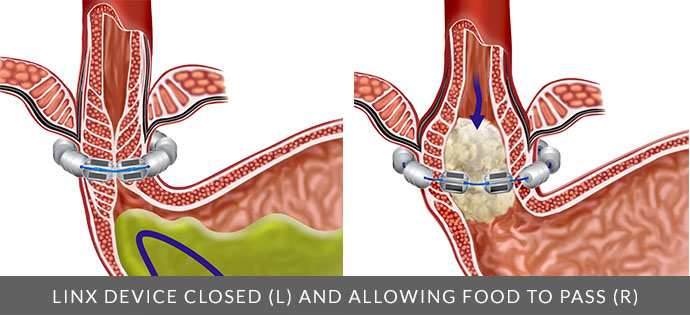LINX for GERD
An exciting and relatively recent development in the treatment and management of Gastroesophageal Reflux Disease is a medical device known as LINX. The device is a small “bracelet” made of titanium beads that is inserted into the abdomen and wrapped around the lower portion of the esophagus at the Lower Esophageal Sphincter (LES). The ends of the bracelet are secured to each other with a magnetic clasp.
Dr. Jacobs discusses the LINX device and how it works:
The LINX device reinforces the LES so that when food passes through the esophagus, the device expands to allow solid and liquid through the opening and into the stomach. The magnetic clasp immediately closes after passage. Gastric juices being pushed from the stomach back toward the esophagus remains blocked. The result is that reflux is controlled and the symptoms of GERD are eliminated entirely in the large majority of cases. Most patients will have a concurrent hiatal hernia which will be repaired during the LINX procedure.
An animation of how the LINX Device functions:
This procedure significantly shortens the surgical dissection and surgical time and lowers the risks. It also appears to give better results. It is of note that the LINX procedure requires hiatal hernia repair if one is present. A Hiatal Hernia repair is done by suturing closed the defect in diaphragm and only allowing the esophagus to pass through. When the hernia is large a mesh may be required.
This device has become our preferred method of GERD management because it offers patients a safer and even less invasive option versus a fundoplication.
Benefits of the LINX Device
Approximately 90-95% of patients see a resolution or an improvement in the symptoms of GERD. Many of these patients enjoy a complete elimination of the effects of acid reflux. Studies for the last 10 years have has shown a significant, long-term benefits after placement of the device.

Another benefit of the LINX device is how quickly it can be placed. The placement of the LINX around the esophagus requires approximately 15-20 minutes of operative time. Total operative time including the hiatal hernia repair is 45-60 minutes. As a result, patients have a significantly reduced risk of operative complications.
The LINX device is removable and unlike a fundoplication, does not alter the anatomy of the stomach. Further, the LINX device usually only requires mild dietary changes after surgery, unlike a fundoplication which requires significant dietary restrictions for several weeks after surgery.
With fundoplications, patients may be unable to vomit or burp, leading at times to abdominal bloating and discomfort. This does not happen with the LINX.
LINX Ideal Patient Profile
The LINX device is suitable for most patients suffering from poorly controlled Gastroesophageal Reflux Disease, as long as they have good esophageal function. It is particularly appropriate for those in whom a fundoplication may not be possible, such as those patients who have had a sleeve gastrectomy (which causes reflux 20-30% of cases), or patients with a shortened esophagus, or for patients in whom a fundoplication has failed.
Risks and Considerations of the LINX Procedure
Of course, the LINX device is not suitable for every patient and only a consultation with qualified surgeons can offer guidance as to whether it is appropriate for your particular circumstance.
Some risks with LINX include:
- Inherent risks of surgery and general anesthesia
- Failure, migration or erosion of the device (rare)
- Difficulty swallowing which may require dilatation or removal (rare)
- Mild transient pain
Some benefits of LINX vs Fundoplication:
- Minimal dietary changes. LINX patients start eating soft foods immediately vs 2-4 weeks
- Patients may belch and vomit, many fundoplication patients can’t.
- May be done as an outpatient procedure



